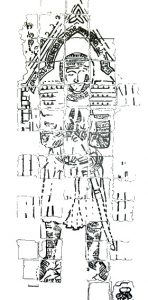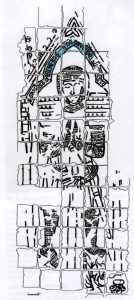Sir Rogon de Balchen and the Abbey of Lieu Dieu
We have long known of the existence of Sir Roger (or Rogon) de Balchen for he is mentioned in two manuscripts in the British Library. The first is dated 1191 and is a deed drawn up in Latin by Bernard IV Count of St Valery who owned vast lands near the Normandy/Picardy border in France as well as on the other side of the Channel near Oxford. In 1191, the Count accompanied King Richard I, Lionheart, on crusade and, before he went, he was anxious to ensure that prayers would be said for his soul, should he perish in the Holy Land. Accordingly he founded an Abbey near Gamaches, close to the modern Abbeville, by purchasing various pieces of land and confirming them in perpetuity to the Cistercian Order. One such area he bought from Sir Rogon de Balchen and in the 1191 deed he gave this to the Abbey which was to be called Lieu Dieu, The Place of God. One of the deed’s witnesses was Sir Rogon, who was a knight in the Count’s service, and who possibly accompanied him to Outremer. In the British Library deed of 1207, Count Thomas, son and heir of Bernard III reiterates the grant to the religious order and again mentions the land (about 40 hectares) which he bought from de Balchen (spelled de Bauchen here).
Sir Rogon had inherited a considerable land holding, some 47 fiefs, which had been given by William the Conqueror, to his ancestor Sire Hugues de Beauchamp, after the Norman invasion of England, for his loyalty during the campaign. Sir Rogon was Seigneur of Beauchamp and of Bouvaincourt, two manors close to each other in the Gamaches area. It is very probable, therefore, that Balchen, Bauchen, Bauchien and ultimately the modern Balchin, are simply derivatives of Beauchamp.
Sir Rogon arranged for his own burial to be in the Abbey of Lieu Dieu of which he had been a benefactor. He died about 1215-1220 and his tomb was decorated with a memorial showing him in complete panoply of chain mail, his head protected by a coif de mailles which is joined to the hauberk or mail shirt. This extends to the hands which are put together in prayer. The legs and feet are covered by long mail chausses. He wears a linen surcoat gathered at the waist with a belt, and probably a guige (shoulder belt), to which a long sword is attached. Above each shoulder are ailettes, meant to protect the neck from blows, each depicts his coat of arms: barry ermine and vert (horizontal bars of ermine and green). Above his head in Picardian Old French is CHI GIST MES SIRE ROGON DE BAUCHEN–PRIE—Here Lies Sir Rogon de Balchen—Pray (for his Soul).
The memorial is extremely interesting in that it is made in glazed tiles in several colours, probably by a monastic tile factory in the area. Later ones were made, of course, of brass and are visible in many of our churches.
Sir Rogon lay undisturbed in the Abbey for many centuries, although the church was partially destroyed around him by Henry V on his way to Agincourt in 1415, again by the Burgundians in 1472, once more by the Calvinists in 1638 and finally raised almost to the ground during the French Revolution.
Lieu Dieu is now an equestrian centre and M & Mme Maillard de Thézy are the present owners. Today, of the Abbey, only part of a tower and of an outhouse remain, although the cloister and garden areas are still very visible. In 1978, under what is now a car park, archaeologists discovered Sir Rogon’s tombstone. In the grave beneath were no human remains. It was photographed and sketched at the time and the tiles removed to the museum at Abbeville. Alas, after thirty years, the tiles are (2009) still in a box in the basement and cannot currently be seen…..However, Mme La Conservateur may hopefully persuade her chiefs to spare her some money for the preservation and display of this unique artefact for it is the only near complete example in existence.


A glance at the sketch(figure, left) shows that at some time, possibly at the end of the 17th century when the church was reconstructed, the tiles of the figure’s lower half have been removed and subsequently replaced in a muddled fashion. No artist who created the Sir Rogon’s torso so carefully would have given him two stumpy left feet! In the drawing, therefore, these tiles have been cut out and moved about into what is probably their original position (there are still many missing) and, based on pictures of early memorial brasses, his legs and surcoat and part of his sword have been completed with dotted lines (figure, right)
The first documentary evidence of Balchins in this country concerns Henry of East Worldham whose signature is on a lay subsidy in 1327. He was born, therefore, around 1280 and is the confirmed ancestor of all the Balchins on the current family tree. He owned some land in West Surrey for which he issued a quitclaim.
In the centuries after the Conquest it was common for Norman knights to own land on both sides of the channel. Because relations between the two countries were unsettled, it was wise for Norman families to settle some of their members in England so that their interests could be looked after in times of strife. We believe, therefore, that a grandson, possibly great grandson, of Sir Rogon de Balchen, Seigneur de Bouvaincourt, settled here on the Surrey-Hampshire-Sussex border and thus his name, which died out in France, became anglicised.
Below is an image of what the tomb would have looked like, by Henrietta Webb.

